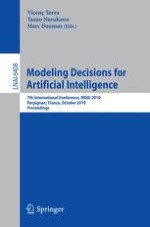2010 | Buch
Modeling Decisions for Artificial Intelligence
7th International Conference, MDAI 2010, Perpignan, France, October 27-29, 2010. Proceedings
herausgegeben von: Vicenç Torra, Yasuo Narukawa, Marc Daumas
Verlag: Springer Berlin Heidelberg
Buchreihe : Lecture Notes in Computer Science
